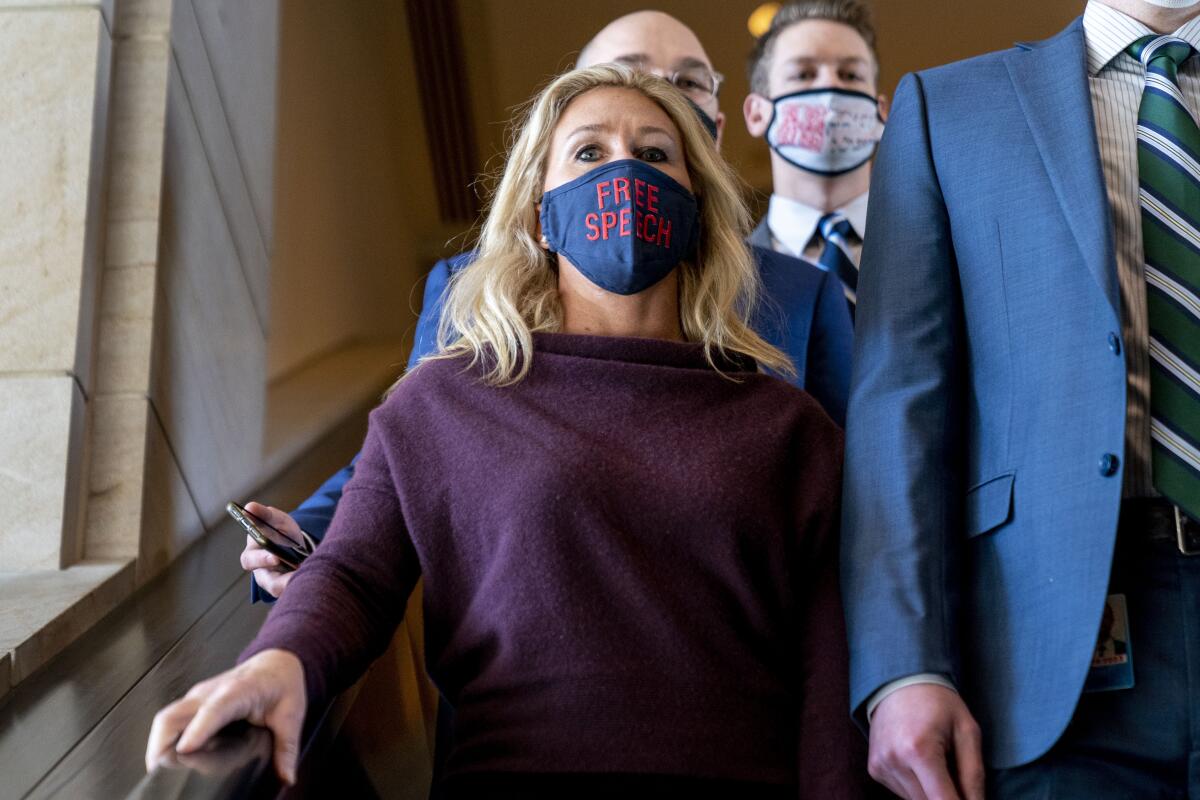Essential Politics: The GOP is split on Rep. Marjorie Taylor Greene. Inaction is strengthening her.

This is the Feb. 5, 2021, edition of the Essential Politics newsletter. Like what you’re reading? Sign up here to get it in your inbox three times a week.
Freshman members of the minority party in the House seldom get much attention, so if notoriety is the goal, Georgia Rep. Marjorie Taylor Greene has had a heck of a week.
Yes, she was roundly denounced by leading senators of her own party, including Senate Republican Leader Mitch McConnell (R-Ky.), who likened her to a “cancer on the Republican party” and denounced her “loony lies and conspiracy theories.”
And, yes, House Republican Leader Kevin McCarthy (R-Bakersfield) gave her what he suggested was a stern talking-to in a private meeting.
And, yes, on Thursday evening, the House voted to kick her off all committees, an action in which 11 Republicans — significantly more than expected — joined all the chamber’s Democrats.
Get our L.A. Times Politics newsletter
The latest news, analysis and insights from our politics team.
You may occasionally receive promotional content from the Los Angeles Times.
Democratic leaders argued they had no choice after Republicans failed to discipline Greene themselves. In social media posts over the past couple of years, before she won election in November, Greene condoned an assassination threat against Speaker Nancy Pelosi (D-San Francisco), suggested that school shootings were “false flag” operations and that the Sept. 11 terrorist attacks were a hoax, and endorsed a wide range of other conspiracy theories.
Among her most outlandish posts was one on Facebook in which she suggested that California’s wildfires might have been caused by lasers she linked to prominent Jewish figures and an invented conspiracy to clear land for the state’s proposed bullet train.
The move against Greene was unprecedented, but there’s little indication the vote will chasten the congresswoman or change her behavior for long. In a statement ahead of the House vote, she did disavow some previous statements, acknowledging that the Sept. 11 attacks “absolutely happened,” but she offered no apologies, blamed the media and portrayed herself as a victim.
“I was allowed to believe things that weren’t true,” she said, adopting an oddly passive voice. Friday morning, she tweeted that she was happy to be off the committees because the work was a waste of her time.
The main impact so far has been to boost her profile and improve her fundraising.
The GOP split
The fight over Greene was just one episode in a month that has shown repeated examples of a deep and bitter division within Republican ranks, pitting a right wing that’s fiercely loyal to former President Trump against a party establishment that would like to be rid of him.
But while the fight continues, there’s little doubt which side currently has the upper hand: Two years ago, Republicans disciplined then-Rep. Steve King of Iowa for bigoted statements that did not come close to Greene’s open avowals of violence. This time, they backed down.
McCarthy has tried to appease both factions of his party caucus. The same day he decided not to take action against Greene, he backed Rep. Liz Cheney (R-Wyo.) in her fight to keep her post in the House leadership. Conservatives tried to oust Cheney after her vote last month in favor of impeaching Trump. On Wednesday, that effort failed during a closed-door meeting of House Republicans, with 61 members, nearly a third of the caucus, voting to remove her.
Battles have flared on the state level as well.
In Arizona, party activists late last month voted to censure Gov. Doug Ducey and Cindy McCain, widow of the late Sen. John McCain. They previously censured former Sen. Jeff Flake — meaning they’ve denounced the only Republicans to win elections for Senate or governor in the state in a decade. McCain and Flake opposed Trump’s reelection, and Ducey angered activists by refusing to back the former president’s claims of election fraud.
Friday, the Nebraska GOP is expected to approve a similar censure of Republican Sen. Ben Sasse for his criticism of Trump. Sasse, who just won another six-year term, shot back in advance, in a video statement to the Nebraska Republican state committee.
“You are welcome to censure me again,” he told them. “But let’s be clear about why this is happening: It’s because I still believe, as you used to, that politics isn’t about the weird worship of one dude.”

Sen. Ben Sasse message to Nebraska’s Republican state committee
“Personality cults aren’t conservative. Conspiracy theories aren’t conservative. Lying that an election has been stolen isn’t conservative. Acting like politics is a religion isn’t conservative,” he said.
“We’re going to have to choose between conservatism and madness.”
Right now, however, the GOP appears to want both.
Party leaders believe they have a good shot of winning back the majority in at least one house of Congress, maybe both, in two years. Republicans would need to flip a net of just six seats in the House and one in the Senate to gain majorities, and the party in the White House typically loses seats in a president’s first midterm election.
But neither the party’s Trump wing nor its establishment wing has enough support to win on its own. That means somehow finding a way to keep both factions on board over the next two years.
The political problem plays out differently in the House and Senate.
Senators must run statewide, and, in most states, that still requires appealing to centrist voters. The GOP’s loss of two Senate seats in Georgia in early January underscored the fear many Republican senators have that Trump and his supporters may be as much a liability as an asset.
That’s the concern which prompted McConnell’s attack on Greene and the similar comments by other leading Republican senators. Many Republican senators would like to reduce — and ultimately eliminate — Trump’s influence in the party, a desire that will hover in the background next week as the Senate sets about trying Trump’s impeachment.
In the House, by contrast, most members represent highly partisan districts and fear primaries more than general elections. That makes them very skittish about crossing Trump or his supporters, including Greene.
A poll by YouGov this week showed that Greene has gained name recognition nationally, and not in a good way: 17% of registered voters had a favorable view of her, 43% were unfavorable. Among Republicans, however, 25% viewed her favorably, including 15% who called their view very favorable. In deeply red districts, that’s more than enough to sway a primary.
As election analyst Dave Wasserman of the Cook Political Report noted this week, the Republican House caucus currently splits roughly into thirds — 61 members on the right voted to oust Cheney; 64 in the establishment wing voted last month in favor of certifying President Biden‘s election victories. In between sit 86 who live in fear of a primary challenge.
That division leaves the party in a muddle. Republicans declined to punish Cheney for voting her conscience, but neither would they punish Greene for her conduct. In trying to keep both factions of the party in harness, they may hope to preserve their chance of winning a majority in 2022, but they did little to suggest they have the discipline to govern.
Biden relief plan takes shape
As Biden settles in at the White House, Californians have a singular message for the new administration: Take care of the coronavirus. That’s the clear message from a new Berkeley Institute of Governmental Studies poll of the state’s voters, and it reinforces the view of Biden aides that his handling of the virus will be the issue on which voters will judge this first phase of his presidency.
Biden’s plan has gotten high marks from the public nationwide so far. That’s partly because while he’s pushing a response to the crisis, Republicans are at war with themselves, Eli Stokols writes. The GOP’s focus on its internal divisions has given it little ability to mount a sustained critique of Biden’s plan. That’s a notable contrast to the experience President Obama faced in 2009.
Most of the debate over Biden’s plan has focused on the size of the direct stimulus checks. But the more lasting impact likely will be a provision that would cut child poverty in half by expanding the existing child tax credit and making it available to low-income families as a refund.
Progressives have pushed that idea for nearly 20 years to no avail. The fact that it’s now on the verge of becoming law vividly illustrates how the policy window has shifted left, in part because of the impact of the COVID pandemic.
As the administration’s COVID relief plan takes shape, Democrats hope to include a provision that would increase subsidies for health insurance under the Affordable Care Act and make the payments available to significantly more middle-class families, Jennifer Haberkorn reported. The move would be a significant win for California, since the federal government would pick up the full cost of a state program that has expanded the subsidies statewide.
Biden’s plan would offer subsidies for any family whose cost of insurance exceeds 8.5% of their income. Currently, the subsidies are limited to those with incomes up to four times the poverty level.
Enjoying this newsletter? Consider subscribing to the Los Angeles Times
Your support helps us deliver the news that matters most. Become a subscriber.
His foreign policy, too
The U.S. has 2,500 troops left in Afghanistan, down from a peak of more than 100,000 a decade ago. But deciding when or whether to pull the last of them out of the country is a tough decision that Trump left in Biden’s lap, David Cloud reports.
Meanwhile, Biden has decided to end U.S. involvement in another war, announcing a halt to support for Saudi Arabia’s war in Yemen. He made the announcement in a speech that marked his first visit to the State Department, where he praised diplomats, who were often a target during the Trump years, Tracy Wilkinson reported.
Wilkinson, who used to cover Rome for the The Times, also looked at the relations between the second American Catholic to be president and the church hierarchy. Pope Francis is a Biden fan, but, much like President Kennedy, Biden is getting a frosty reception from some Catholic leaders.
The latest from California — the recall
Foes of Gov. Gavin Newsom reported raising more than $2.5 million for the recall effort. That’s not yet as much as they would likely need to get the recall on the ballot, but they’re getting close, Seema Mehta reported.
The U.S. has seen only three efforts to recall a governor since states began adopting recall provisions early in the 20th century. Paul Maslin has now had a ringside seat for two of those three — the successful recall of Gray Davis in California and the unsuccessful effort to take down Scott Walker in Wisconsin. Maslin talked with Mark Barabak about why he thinks Newsom will survive a recall attempt.
The federal government set up two new COVID-19 vaccine sites in California to focus on elderly people in communities particularly hard-hit by COVID-19, Chris Megerian and Colleen Shalby reported. The sites at Cal State LA and the Oakland Coliseum were among the first of roughly 100 planned nationwide, said Jeff Zients, who heads Biden’s COVID-19 taskforce.
Stay in touch
Send your comments, suggestions and news tips to politics@latimes.com. If you like this newsletter, tell your friends to sign up.
Until next time, keep track of all the developments in national politics and the Trump administration on our Politics page and on Twitter at @latimespolitics.
Get the L.A. Times Politics newsletter
Deeply reported insights into legislation, politics and policy from Sacramento, Washington and beyond. In your inbox three times per week.
You may occasionally receive promotional content from the Los Angeles Times.




